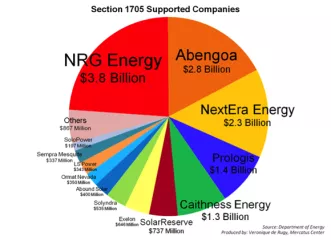- | Government Spending Government Spending
- | Expert Commentary Expert Commentary
- |
Another Loan Guarantee Recipient Bites the Dust
Remember Solyndra? The Washington Times reports that Abound Solar, maker of solar panels and recipient of a $400 million loan guarantee from the Federal Government, announced Thursday that it would file for bankruptcy. The cost to taxpayers: roughly $70 million. Obviously, it doesn’t compare to the $538 million that the Solyndra bankruptcy will cost taxpayers but $70 million is still a big deal.
Remember Solyndra? The Washington Times reports that Abound Solar, maker of solar panels and recipient of a $400 million loan guarantee from the Federal Government, announced Thursday that it would file for bankruptcy. The cost to taxpayers: roughly $70 million. Obviously, it doesn’t compare to the $538 million that the Solyndra bankruptcy will cost taxpayers but $70 million is still a big deal.
As I have mentioned in the past, the government should get out of the lending business and the venture-capitalist business because it is not its role and it is not good at it. As a general rule, these loans go to two different types of companies:
- Companies that generally don’t have access to capital because the project they are trying to get funded is too risky for the private sector. In that case, the risk often comes from the fact that the company has a bad business model and as a result it fails. Solyndra, obviously, is a good example, but small-business loans fall in that category, too. Taxpayers end up footing the bill.
- Companies that would have access to capital but would rather benefit from the much better terms offered by the government guarantee. There is a difference between not having access to credit at all and not having access to credit at low rates or not having access to as much credit as one would like. In the case of the 1705 loan program, roughly 90 percent of the money went to large and well-established companies with easy access to capital such as the loan that went to a wholly owned subsidiary of Goldman Sachs. The winners in this category are often well-connected politically (as they may be in the other one, too). And while their projects are often low risk, these loans distort important market signals and redirect private capital toward “government supported” projects regardless of their merits.
In other words, these loans either go to companies that are too risky and shouldn’t get them or to companies that don’t need them. That’s true for energy loans and for any other loan-guarantee program. They need to be terminated. Solyndra and Abound Solar are only the tip of the iceberg.
